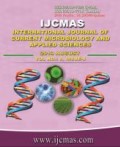


 National Academy of Agricultural Sciences (NAAS)
National Academy of Agricultural Sciences (NAAS)

|
PRINT ISSN : 2319-7692
Online ISSN : 2319-7706 Issues : 12 per year Publisher : Excellent Publishers Email : editorijcmas@gmail.com / submit@ijcmas.com Editor-in-chief: Dr.M.Prakash Index Copernicus ICV 2018: 95.39 NAAS RATING 2020: 5.38 |
Infection complicates the pathological picture of diabetic foot and plays a main role in development of moist gangrene. A total sample size of 100 patients with diabetic foot ulcer was included in this cross sectional study. A detailed history was obtained and assessment of clinical symptoms and signs were made. Discharge from the lesions, pus aspirates from the abscesses and debrided necrotic materials were collected. Aerobic culture anerobic culture and antibiotic susceptibility testing was done. Males were the predominant group in this study 66% as compared to females 34%. Most of the patients (98%) had type 2 Diabetes Mellitus. Around 50% of the patients had Diabetes Mellitus for less than 5 years and the rest had Diabetes Mellitus for a period more than five years. Poor glycemic control was present in 90% cases and was a significant risk factor in relation to foot ulceration. Out of 100 samples 95 samples were culture positive. From the 95 culture positive patients 130 isolates were isolated as average 1.36 isolates per patient. The majority of the patients were infected with aerobes only. (89%) Both aerobic and anaerobic organism could be isolated in the remaining patients. (11%) Gram positive organisms were isolated in 53 patients. Staphylococcus aerues was the commonest isolate. Resistance to cotrimoxazole, cefotaxime, gentamycin was noticed among the gram negative bacteria.
 |
 |
 |
 |
 |